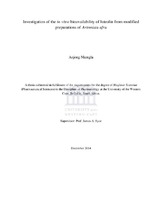| dc.description.abstract | Artemisia afra (A. afra) is traditionally used for a variety of ailments and contain flavonoids e.g. luteolin which may contribute to some of its activity. It is generally administered as a tea or decoction, and such liquid dosage forms present challenges as far as long term storage and stability are concerned, as well as sub-optimal oral bioavailability of actives they contain. Freeze dried aqueous extracts (FDAE) can alleviate such problems but may be hygroscopic and unstable. The use of modified forms of FDAE can counter the problem of hygroscopicity (e.g. use of alginate) and alleviate the issue of sub-optimal bioavailability of plant actives (e.g. polymethylmethacrylate). The objectives of this study, were to: (1) prepare the freeze dried aqueous extract (FDAE) and modified forms, which include alginate-extract beads (alginate-FDAE) and polymethylmethacrylate coated alginate matrix beads of herbal extract (PMMA-alginate-FDAE) of the FDAE of A. afra, (2) determine and compare the pharmaceutical characteristics of the above mentioned preparations of A. afra,(3) quantify and compare the total flavonoid and specifically luteolin levels of the different forms of A. afra,(4) evaluate and compare the release characteristics of FDAE of A. afra from the alginate-FDAE and PMMA-alginate-FDAE beads in gastrointestinal fluids and (5) determine the intestinal permeability of luteolin contained in selected modified Artemisia afra extract preparations. It was hypothesized that making the alginate beads and the polymethylmethacrylate coated alginate beads would make the FDAE less hygroscopic with a lower moisture content, that the rate of release of luteolin from A. afra FDAE into gastrointestinal fluids would be faster than from the modified forms, and that the effective gastrointestinal permeability of luteolin in the alginate-FDAE and PMMA-alginate-FDAE beads of A. afra is equal to that in FDAE. To realize these objectives, the FDAE was prepared by freeze drying the aqueous extract of the A. afra dried leaves, alginate-FDAE prepared by dispersing FDAE into 4% sodium alginate solution, then adding the resulting stock solution into a 2% calcium chloride solution and drying resulting beads and PMMA-alginate-FDAE prepared by a modified water-in-oil-in-water emulsion solvent evaporation method using water as an internal aqueous phase. Using pharmacopoeial methods and methods adapted from other workers the organoleptic and pharmaceutical characteristics were determined to compare the pharmaceutical quality of these preparations of A. afra. To identify and determine the levels of luteolin in the plant preparations, a validated HPLC assay was developed. Finally, the in situ perfused rat intestine model was used to determine the in vitro bioavailability, i.e. gastrointestinal permeability, of luteolin from solutions containing luteolin in pure form, FDAE, alginate-FDAE and PMMA-alginate-FDAE. The A. afra forms were obtained in moderate to good yields and FDAE was brown and hygroscopic in nature, the alginate beads dark brown free flowing and spherical in shape and the PMMA-alginate beads light brown in colour with rough edges. The A. afra plant forms on average contained 0.185 ± 0.24, 0.067 ± 0.014, 0.012 ± 0.071 μg/mg of free luteolin (n=3) in FDAE, alginate-FDAE and PMMA-alginate-FDAE respectively and 0.235 ± 0.026, 0.079 ± 0.093, 0.058 ± 0.082 μg/mg of total luteolin (n=3) in FDAE, alginate-FDAE and PMMAalginate- FDAE respectively. The Plumen values for intestinal uptake of luteolin were significantly higher from solutions of A. afra forms than the pure luteolin solution (i.e. Plumen values in the range of 0.02 - 0.035 cm/s for all plant forms vs Plumen values in the range of 0.010 - 0.014 cm/s for pure luteolin, t-test p = 0.0252). The permeability of luteolin in FDAE appeared to be slighter greater than that of the modified forms (Plumen values >0.03 cm/s for FDAE and Plumen values <0.03 cm/s for both modified forms). In summary, the results showed that, the modified A. afra forms; alginate-FDAE and PMMAalginate- FDAE were of acceptable pharmaceutical quality with luteolin better taken up in the plant forms than in its pure form. The A. afra forms prepared had similar rates of uptake (permeability) of free and total luteolin with the rates being highest for the FDAE. Collectively, these results indicate that alginate-FDAE and PMMA-alginate-FDAE bead forms should be suitable for use in a solid dosage form (e.g. tablet or capsule) of A. afra. | en_US |

